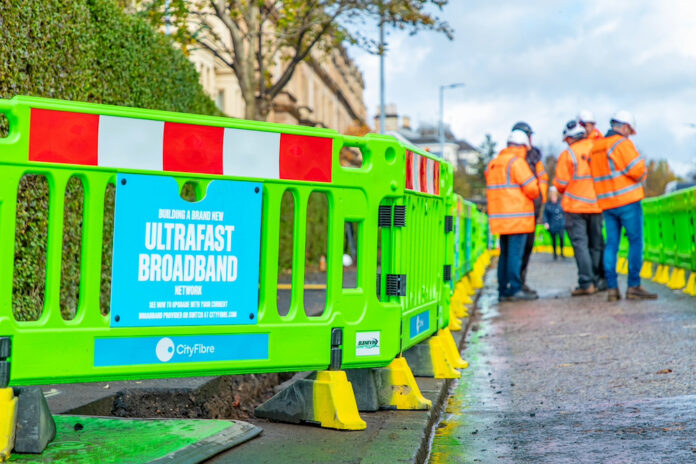Forget homes passed, lenders want to see homes connected and ARPU
CityFibre this week announced that its 10Gbps full fibre (FTTP) network now passes more than three million UK premises with 2.6m of these being ready for service – meaning consumers can order a service.
Meanwhile, altnet Fibrus has also released its network coverage data to the end of August confirming it has reached 300,000 homes of which 273,000 are ready to be connected to fibre broadband. Fibrus announced reaching a quarter of a million homes back in March.
Despite the milestones PwC restructuring specialist Issy Gross told Infralogic UK fibre network operators were now facing much closer investor scrutiny which is leading to consolidation, cost cutting and in some cases like Broadway Partners, failure.
CityFibre wants to stick to plan
CityFibre’s original plan was to cover up to eight million premises – around 30% of the UK – by 2025. However, like all fibre altnets in the market, the carrier is faced with rising build costs, increasing competition from other overbuilders – and the likes of incumbent Openreach and Virgin Media O2 – and the need to show investors it is hitting the right take-up levels to remain viable.
The altnet has already shed several hundred jobs earlier this year but is confident it can meet its plans despite not building at a pace that will see it reach the target in its initial plan. CityFibre began the construction of its access network in 2018, commencing mobilisation in its first 12 towns and cities.
It has since achieved primary build complete status in multiple locations including Milton Keynes, Stirling, Peterborough and Coventry. In its most mature locations, such as Milton Keynes, ISP partners are now approaching 30% take-up with other locations growing on a similar trajectory.
By the end of 2023, CityFibre expects to have deployed its XGS-PON equipment into over 90% of its fibre exchanges with the new 2.5Gbps product becoming available to around 20% of its ready for service footprint, currently.
Earlier this year CityFibre also recently secured four Project Gigabit contract awards, totalling £387m in government subsidies to reach 262,000 homes in the final 20% of hardest to reach premises. This has been supported by nearly £223m of committed private investment from CityFibre, representing a combined total investment in Project Gigabit’s target areas of £610m. Within its existing home build programme, CityFibre will also complement its Project Gigabit rollouts in the four counties with expansion to an additional 453,000 premises.
Fibrus hits new milestone
Altnet Fibrus announced it has now more than 50,000 customers on its network in Northern Ireland and Northern England meaning its take-up rate is just over 18%. “Connecting 50,000 customers is an important milestone in our mission to bring Full Fibre broadband to homes and businesses to rural and regional areas of the UK. It shows the momentum we are building in the market, having tripled our customer base in just one year,” said financial officer and chief revenue officer Colin Hutchinson.
To fund this continued growth, the altnet this week received an additional £35m tranche of equity funding from its shareholder Infracapital bringing its total investment in Fibrus to £150m. Fibrus’s network roll out is also financed by its existing £220 million loan facility and more than £300m in government funding.
Earlier this year, the first homes in the UK’s first regional Project Gigabit procurement in Cumbria were connected in Aspatria with customer penetration exceeding 20% within one month of launch. Fibrus has also confirmed that it is planning to raise further equity and debt to fund its #R21M (road to one million) plan which also includes more Project Gigabit contracts.
Lender caveat emptor
PwC’s Gross told Infralogic there is much more focus on factors such as how many of their potential customers fibre companies have signed up and average revenue per user, compared to 12-18 months ago. “Capital providers are now much more focused on the all-important question of current and realistically forecast cash generation,” said Gross.
Several lenders already have big exposures to fibre altnets and are more and more reluctant to increase their exposure. Meanwhile, debt funds and other banks are also looking to enter the sector, the debt they provide is likely to be more expensive, according to Gross.
As a result, cost cutting is more prevalent and this can mean job cuts like KKR Infrastructure’s Hyperoptic among those announcing redundancies recently. Gross added that while some M&A will work: “valuation discussions can be complex when trying to evaluate different business models against each other”.
She highlighted Cityfibre’s joint venture with Amber Infrastructure Partners-backed toob as a successful collaboration model. Under a deal agreed last year, toob gave CityFibre’s ISP retail partners access to its network in the south of England, while toob, itself an ISP, gained access to CityFibre’s network in neighbouring areas such as Portsmouth.
Read our report on the FTTH Council Europe’s comprehensive research into what’s stopping consumers across Europe signing up for FTTH here.



